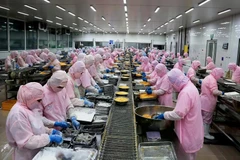Hanoi (VNA) - While the European Union's Circular Economy Action Plan (CEAP) is posing new challenge for Vietnamese exports, it also offers opportunities and reflects a global trend, heard a seminar held in Hanoi on November 27.
Organised by the Ministry of Industry and Trade (MoIT), the event examined CEAP and its pacts on Vietnamese businesses.
The EU-Vietnam Free Trade Agreement (EVFTA) has significantly boosted trade between Vietnam and the European Union (EU) after four years of its enforcement. With bilateral trade reaching nearly 64 billion USD, the EU has become one of Vietnam's major export markets.
Thanks to the tariff advantages of EVFTA, most of Vietnam's export items have recorded impressive growth, such as industrial goods, chemicals and especially agricultural and aquatic products.
However, to sustain this momentum, Vietnamese businesses now face a major challenge - the EU’s CEAP.

A representative from the Europe-Americas Market Department under the MoIT explained that the CEAP is a cornerstone of the EU’s strategy to achieve net-zero emissions by 2050. It introduces stricter regulations for industries such as electronics, IT, batteries, packaging, plastics, textiles, and footwear. Products failing to meet these standards will face difficulties entering the EU market.
Complying with these regulations needs substantial investments in production upgrades and changes to management practices. While these investments increase production costs and may impact competitiveness in the short term, they also create long-term opportunities, such as tapping into new customer segments and achieving cost efficiencies for businesses that meet the standards

Nguyen Xuan Duong, Chairman of the Board of Directors at Hung Yen Garment Company, noted that the company’s export turnover to the EU has doubled since the EVFTA came into effect. However, he highlighted challenges with meeting the agreement's rules of origin requirements, particularly for materials sourced outside the EU.
Dr. Mai Thanh Dung, Deputy Director of the Institute of Strategy and Policy on Natural Resources and Environment, emphasised that businesses adopting circular economic solutions will enjoy greater efficiency in production and operations. These solutions can help reduce input material consumption and extend product life cycles.
Nevertheless, he acknowledged that most small and medium-sized enterprises (SMEs) in Vietnam face financial constraints that limit their ability to invest in technology and production innovation. He stressed that transitioning to a green and circular economy is an irreversible trend, essential for enterprises to remain part of the global value chain and competitive in demanding markets.

To stay competitive, experts said Vietnamese businesses need to adapt quickly to these changes by implementing circular economy practices, that will not only help maintain their market share in the EU but also open up new growth opportunities in other large markets.
In addition, they suggested that the government and relevant agencies take prompt actions to provide support and guidance, ensuring that Vietnamese exports maintain their advantages under the EVFTA and remain competitive in the global value chain.
For their part, businesses must proactively shift their production practices toward sustainability and circularity. Aligning with the European Green Deal and the CEAP will allow Vietnamese enterprises to fully benefit from the opportunities that the EVFTA offers, they concluded./.




























